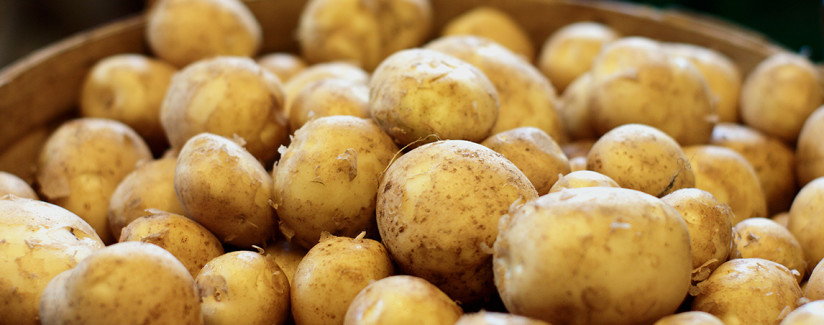
New Potato: Less bruising and browning
Update (5/15/2015) – While not yet available in stores, the Innate Potato is only the 10th genetically modified food to be approved by the USDA, FDA and EPA. Check out this infographic to learn more.
The USDA approved commercial planting of a potato that resists browning and has fewer unsightly and wasteful bruises. It’s called the Innate™ brand and could be coming to a supermarket near you in the not-too-distant future.
We went to Dr. David Douches, Director of the Potato Breeding and Genetics Program at Michigan State University, and Doug Cole of J.R. Simplot, the company that developed the new potato, for more information.
Why name it the Innate™ potato?
Dr. Douches:
The name does a good job of describing the process. The technology used to produce it involves isolating genetic elements from the plant’s existing gene structure, and after some rearranging, introducing them back into the potato without incorporating genes from other species. The product is from within; we are adding something new, but it was already in the potato in the first place. There are no new proteins being produced.
What is different about this new potato?
Cole:
Black spot bruising in potatoes is the leading complaint by consumers and they will see much less of it in the Innate™ brand. The potatoes also don’t turn brown when exposed to the air after being cut, preventing the need to soak them after peeling. We think consumers will find the product more appealing and there will be less waste from cutting out bruises.
How do we know this new potato will be safe?
Dr. Douches:
There are very strict government regulatory systems in place for all genetically engineered plants seeking commercialization. This process includes an intense review process by the USDA, FDA, and even the EPA in some cases. All of these are to make sure that the product being developed is both safe to eat for consumers and safe to grow for the environment.
There has been concern about GMO foods being linked to increased allergies. Any concerns here?
Dr. Douches:
Actually, testing for allergens is part of the government review process. There has never been a released product that contained allergens through GMO products.
Cole:
Since only genes from wild and cultivated potatoes are utilized in the breeding, there is no risk of new allergens being created.
The FDA suggests people try to reduce their consumption of a compound found in well- and over-cooked foods, called acrylamide. Does this new potato address this issue?
Cole:
This potato reduces the potential for the formation of acrylamide, which is a naturally-occurring chemical compound found in most starchy foods. Innate™ potatoes have up to 70 percent less acrylamide than other potatoes cooked at high temperatures.
Will this be the same as GMO corn and soybeans in that you can spray herbicides on them to kill weeds and not the potato plant and the plants will contain a pesticide to ward off insects?
Dr. Douches:
Weed control in potatoes is not as large of a problem as in crops like corn and soybeans. This is because potatoes have an excellent canopy (a term used in farming to describe the crop’s leaves spreading out and blocking the sun from potential weeds). As far as insects go, potatoes do have a number of pests, but with the Simplot strategy of using genes, they do not have a trait that targets insects at this point. That may be something that will be implemented somewhere down the line, but not now.
Cole:
The first generation of Innate™ potatoes contains only potato genes and are not disease resistant. They grow just like regular potatoes without the need for special pesticides, herbicides or fertilizers. Our next generation, expected to be out in two years, will be resistant to Late Blight, which caused the Irish Potato Famine. This resistance will be done with all-potato genes similar to the first version and won’t require any additional pesticides.
Will people notice anything different about the taste or texture of these potatoes?
Dr. Douches:
There is nothing different about the texture. When processing French fries and potato chips from these potatoes, there are fewer defects, which results in less waste in the plants. There will be more quality plants going down the line and into potato products.
Cole:
These potatoes have the same sensory characteristics of their conventional counterparts – including taste, size and texture.
Will they cost more?
Cole:
The price to consumers will be determined by retailers once the potatoes are available in the marketplace.
Image: “Potatoes” by Jamonation is licensed under CC BY 2.0.

























